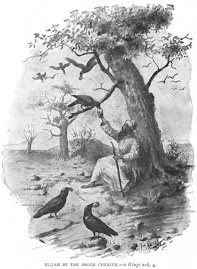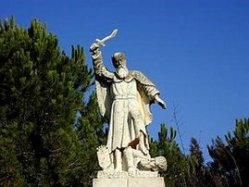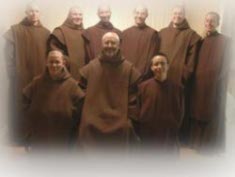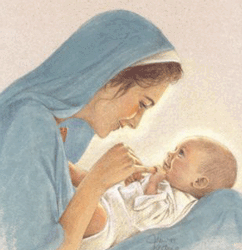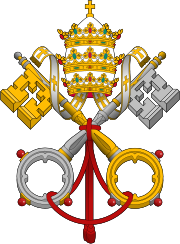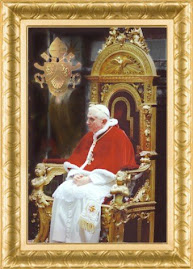Today, on October 28, 2007 at the Basilica of St. Paul Outside the Walls in Rome, 498 martyrs of the 20th century in Spain will be beatified.
Carmelites in Barcelona at the onset of civil war
The friars at the Carmelite monastery in Barcelona, located at the corner of LIuria Street and Diagonal Avenue, were still asleep at 4:30 Sunday morning when suddenly they were awakened by shouts and banging at the door. On that morning of July 19, 1936, the quiet streets of Barcelona had turned into a battlefield when nationalist troops were sent to secure the cross streets between Paseo de Gracia and Diagonal. The troops were ambushed between Callis and Llüria Street by republican assault guards and city militia. The civil war had come to Barcelona. The sounds of horrible gun fire and the militia shouting “Viva Ia Republica” and “Viva el Ejercito” grew louder and louder. The banging at the door was increasingly frantic— shouting through the door that the wounded needed care. The monastery door was opened and infantry men from the Santiago cavalry barged in bringing with them several armed soldiers. The community had rapidly set up an infirmary in the largest room in the monastery close to the entrance. They had laid the wounded on mattresses that the friars had taken from all their cells. Food was scarce for so many inside, but the friars made sure that the wounded and fatigued were well nourished, even if it meant abstaining from food themselves. Soldiers from the infantry continued to storm into the monastery bringing weapons and ammunition and placing themselves in strategic areas throughout the compound and turning the Carmelite monastery into a military fort.
An American reporter, Magan Laird, was vacationing with her family at an apartment across from the monastery when she heard what sounded like firecrackers and rockets. But when she looked out of her apartment and found no one coming out, she knew something was wrong: “The first sign of life is a private car coming rapidly up Calle Lluria ... It stops in the next block in front of the church and monastery of the Carmelites. Two assault guards get out hurriedly, grasp the rifles in firing position, and station themselves behind a tree. At the same moment, I see other assault guards running, rifles in their hands, down the diagonal, another block away ... There is a crackle and a puff of smoke from the tower of the Carmelite church. In the street below, an assault guard, sheltered behind a tree knoll, raises his rifle and fires ... this is no fiesta. This is war.” The cavalry had set a perimeter with soldiers on the bell tower, on windows inside the cells, and church areas. Laird recounts, “From time to time the air is torn with their sharp pum-pum-pum ... Suddenly the drone of an airplane motor is heard directly above our heads. In a minute the plane itself dips into our line of vision, flying high and circling above the Carmelite church. There is the sharp rattle of machine guns from the plane. They are firing at random on the streets and houses below.” In the midst of this chaos, the whole Carmelite community was able to celebrate Sunday Mass and pray the Divine Office. As evening drew near, the wounded were transferred to the library where they would be safer and make more space for the incoming troops from the street. “Cars are passing more frequently in the streets—beautiful cars, luxurious limousines, and open sport models, polished and shining—the cars of the wealthy, filled now with men and soldiers in shirt sleeves, firing constantly as they careen wildly through the streets. All of them have painted letters on the sides — FAI and CNT ...“ The streets finally fell quiet late Sunday night. Inside the monastery, as it was forbidden to light any lamps, many soldiers rested in the pews, refectory, sacristy, and basement. The Carmelites did not go back to their cells but attended to the needs of the soldiers and prisoners who had been captured by the military. “The night air is very cold ... here and there, among darkened buildings of the city, rises a column of white, heavy smoke. They are burning the churches. Off to the right, and elevated on a little hill, one church stands up like liquid gold against the night.” Early Monday morning, the friars celebrated Mass in the middle of gunfire, which was heavier than Sunday. Throughout the morning, many officers and troops inside came to the Carmelites to be enrolled in the Scapular of Our Lady of Mt. Carmel. With no reinforcements to relieve the soldiers, it was a matter of time before they could no longer hold down the monastery. Seeing that surrender was inevitable, the Carmelite community gathered in the church and knelt before the Blessed Sacrament. Fr. Lucas, the provincial, proceeded to distribute all the consecrated hosts to be consumed. Shortly after this, everyone was alerted that there was an agreement to surrender, with the condition that the lives of the officers, the troops, the wounded, and the religious be spared.
For safety, the Carmelites were told not to wear their habits outside, One friar recalls: “We took off our Carmelite habits and clothed ourselves in civilian attire ... all of us were ready to die after having received the Sacrament of Reconciliation and the Eucharist.” Laird continues: “Presently, in the top of the bell tower, the white flag is run up. Instantly the streets are filled with cheering mobs. The police are powerless to hold them back; they surge against the church, shaking their fists, dancing with rage. Many carry lighted torches.” The mob had infiltrated the monastery by breaking doors and windows. The civil guard was able to give some of the friars a safe passage outside, but the mob became so uncontrollable that there was no longer any guarantee for their safety. Some friars tried to escape by blending with the crowd, but for some it was no use. Fr. Jorge of St. Joseph and Bro. Juan Jose of Jesus were killed as soon as they were discovered to be friars.
Carmelites in Barcelona at the onset of civil war
The friars at the Carmelite monastery in Barcelona, located at the corner of LIuria Street and Diagonal Avenue, were still asleep at 4:30 Sunday morning when suddenly they were awakened by shouts and banging at the door. On that morning of July 19, 1936, the quiet streets of Barcelona had turned into a battlefield when nationalist troops were sent to secure the cross streets between Paseo de Gracia and Diagonal. The troops were ambushed between Callis and Llüria Street by republican assault guards and city militia. The civil war had come to Barcelona. The sounds of horrible gun fire and the militia shouting “Viva Ia Republica” and “Viva el Ejercito” grew louder and louder. The banging at the door was increasingly frantic— shouting through the door that the wounded needed care. The monastery door was opened and infantry men from the Santiago cavalry barged in bringing with them several armed soldiers. The community had rapidly set up an infirmary in the largest room in the monastery close to the entrance. They had laid the wounded on mattresses that the friars had taken from all their cells. Food was scarce for so many inside, but the friars made sure that the wounded and fatigued were well nourished, even if it meant abstaining from food themselves. Soldiers from the infantry continued to storm into the monastery bringing weapons and ammunition and placing themselves in strategic areas throughout the compound and turning the Carmelite monastery into a military fort.
An American reporter, Magan Laird, was vacationing with her family at an apartment across from the monastery when she heard what sounded like firecrackers and rockets. But when she looked out of her apartment and found no one coming out, she knew something was wrong: “The first sign of life is a private car coming rapidly up Calle Lluria ... It stops in the next block in front of the church and monastery of the Carmelites. Two assault guards get out hurriedly, grasp the rifles in firing position, and station themselves behind a tree. At the same moment, I see other assault guards running, rifles in their hands, down the diagonal, another block away ... There is a crackle and a puff of smoke from the tower of the Carmelite church. In the street below, an assault guard, sheltered behind a tree knoll, raises his rifle and fires ... this is no fiesta. This is war.” The cavalry had set a perimeter with soldiers on the bell tower, on windows inside the cells, and church areas. Laird recounts, “From time to time the air is torn with their sharp pum-pum-pum ... Suddenly the drone of an airplane motor is heard directly above our heads. In a minute the plane itself dips into our line of vision, flying high and circling above the Carmelite church. There is the sharp rattle of machine guns from the plane. They are firing at random on the streets and houses below.” In the midst of this chaos, the whole Carmelite community was able to celebrate Sunday Mass and pray the Divine Office. As evening drew near, the wounded were transferred to the library where they would be safer and make more space for the incoming troops from the street. “Cars are passing more frequently in the streets—beautiful cars, luxurious limousines, and open sport models, polished and shining—the cars of the wealthy, filled now with men and soldiers in shirt sleeves, firing constantly as they careen wildly through the streets. All of them have painted letters on the sides — FAI and CNT ...“ The streets finally fell quiet late Sunday night. Inside the monastery, as it was forbidden to light any lamps, many soldiers rested in the pews, refectory, sacristy, and basement. The Carmelites did not go back to their cells but attended to the needs of the soldiers and prisoners who had been captured by the military. “The night air is very cold ... here and there, among darkened buildings of the city, rises a column of white, heavy smoke. They are burning the churches. Off to the right, and elevated on a little hill, one church stands up like liquid gold against the night.” Early Monday morning, the friars celebrated Mass in the middle of gunfire, which was heavier than Sunday. Throughout the morning, many officers and troops inside came to the Carmelites to be enrolled in the Scapular of Our Lady of Mt. Carmel. With no reinforcements to relieve the soldiers, it was a matter of time before they could no longer hold down the monastery. Seeing that surrender was inevitable, the Carmelite community gathered in the church and knelt before the Blessed Sacrament. Fr. Lucas, the provincial, proceeded to distribute all the consecrated hosts to be consumed. Shortly after this, everyone was alerted that there was an agreement to surrender, with the condition that the lives of the officers, the troops, the wounded, and the religious be spared.
For safety, the Carmelites were told not to wear their habits outside, One friar recalls: “We took off our Carmelite habits and clothed ourselves in civilian attire ... all of us were ready to die after having received the Sacrament of Reconciliation and the Eucharist.” Laird continues: “Presently, in the top of the bell tower, the white flag is run up. Instantly the streets are filled with cheering mobs. The police are powerless to hold them back; they surge against the church, shaking their fists, dancing with rage. Many carry lighted torches.” The mob had infiltrated the monastery by breaking doors and windows. The civil guard was able to give some of the friars a safe passage outside, but the mob became so uncontrollable that there was no longer any guarantee for their safety. Some friars tried to escape by blending with the crowd, but for some it was no use. Fr. Jorge of St. Joseph and Bro. Juan Jose of Jesus were killed as soon as they were discovered to be friars.
 Martyrdom of Fr. Lucas of St. Joseph (Tristany), O.C.D.
Martyrdom of Fr. Lucas of St. Joseph (Tristany), O.C.D.Witnesses testify to seeing Fr. Lucas as he came out of the monastery through the smaller door adjacent to the tower bell with his face covered with blood, his head bandaged with a colored handkerchief, and accompanied by two civil guards. The mob wanted to lynch Father, but the soldiers forced them back telling them they wanted to take him to the authorities. As they approached Diagonal Avenue, one of the civil guards with him said, “I gave you my word that I will save your life.” From a distance, however, a patrol shot the guard in the head killing him. The other soldiers fell back as the mob grew restlessly violent. Fr. Lucas crossed Diagonal Avenue alone under fire and took refuge before a large portal. A patrol, armed with two rifles, pushed him ruthlessly onto the Avenue. The patrol approached him again striking him on the head with rifle butts. Fr. Lucas was ordered to walk down the Avenue and “with an uncertain gait, he staggers slowly down the Diagonal, his palms joined before his breast praying.” After walking a few yards, he was shot from behind and fell to the ground. Wounded, Fr. Lucas was able to crawl some distance before he died near a small oak tree in front of a doctor’s clinic on Diagonal Avenue. Fr. Lucas was lying on the ground with his face turned to the Carmelite monastery until 8 o’clock that night when a Red Cross ambulance from Lluria Street came to take away the body.
Martyrdom of Fr. Eduardo of the Child Jesus (Farré), O.C.D.
Fr. Eduardo, who was prior of the community in Tarragona at that time, was preaching a novena to Our Lady of Mt. Carmel to the Carmelite nuns in Tiana, for it was a custom at that monastery to begin the novena on the 16th. On the feast day of St. Elijah (July 20), Fr. Eduardo received news of the war and urged the nuns to be ready to leave the cloister. By midmorning, they saw their neighboring church on fire and rapidly changed into civilian clothes and left the cloister safely.

Outside, before they parted to take refuge at family homes, the nuns knelt for a blessing from Fr. Eduardo who told them that this could be their last meeting—“until we meet again in heaven. ”
Frs. Gabriel and Eduardo took refuge at the home of the Noruega family. The fathers found a welcoming and loving home where they could feel protected. Perhaps such notion of safety and optimism made the priests less cautious and fearless of their surroundings. The priests would secretly go to the nuns to celebrate Mass for them until it became too dangerous. At 6 o’clock in the evening of July 25, as the priests and family were at home, they saw about thirty militia men running in formation past the house with more riding in privately-owned vehicles.
Some of them surrounded the Noruega’s house and entered through the door demanding to register and inspect the household. Mr. Noruega, realizing that the inspection might cost the lives of the priests, asked them what to do. Fr. Gabriel suggested that he tell them they were just friends of the family. However Fr. Eduardo with great fervor and courage strongly disagreed and said that they should know who they were. As the militia interrogated the family and turned to the priests, these words were heard: “Yes sir! We are two Discalced Carmelite friars!” They seized them immediately and took them to headquarters. The friars were transferred to a large truck where a woman armed with a rifle directed them on board. That was the last time they were seen. It is speculated that their bodies were buried in common graves perhaps near the town of Montcada. Fr. Eduardo died at the age of 39.
Text after California-Arizone Province of Discalced Carmelite Friars




